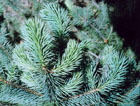Conservation Status

Picea chihuahuana
Martínez 1942
Common names
Cahuite, cahuite espinoso, cahuite bravo, pinabete espinoso (Ledig et al. 2000); Chihuahua spruce (Farjon 1990).
Taxonomic notes
First recorded in 1942 from Talayotes in Chihuahua (Martínez 1953).
As noted in the Picea description, molecular analysis by Ran et al. (2006) clearly indicates that P. chihuahana is not related
to the northern North American spruces, but shares a sub-clade with eight other species native to west Asia, the eastern Himalaya, Taiwan and Japan. The evolutionary history that may have produced this peculiar pattern remains a mystery. That study did not consider the other Mexican spruces, Picea martinezii and P. mexicana (here treated as P. engelmannii var. mexicana). Picea martinezii was formerly considered synonymous with P. chihuahuana (Farjon 1990), but proved clearly distinct on detailed analysis, "justifying the retention of P. martinezii as a separate species" in the opinion of Taylor et al. (1994), a determination separately confirmed by Ledig et al. (2004) in an analysis using multiple independent lines of molecular data. Those data, however, also show that the two taxa are sisters, so P. martinezii could reasonably be treated as a variety or subspecies of P. chihuahuana, though those combinations have not to my knowledge yet been made.
Description
A tree to 25-35 m tall and 45-70 cm dbh, with pale grey furrowed and scaling bark. Crown narrow-conic, open with few long level branches among more numerous very short branches. Shoots stout, pale buff. Leaves blue-green, matt with conspicuous stomatal lines, 17-23 mm long, rhombic to slightly flattened in cross-section, exceedingly sharp (readily drawing blood when shoots grasped!) with a long spine tip. Cones green ripening orange-brown, cylindrical, 7-12 cm long, 4-5 cm broad when open with tightly packed or even congested scales 18-23 mm long and 14-20 mm wide, apex truncated, almost square-ended. Seed 3.5-4 mm, black, with a 10-12 mm wing. (Martínez 1953, Gordon 1968, Nienstaedt 1983, Taylor et al. 1994, and cones in M. P. Frankis collection).
See P. martinezii for differences from that species.
Distribution and Ecology
Mexico: SW Chihuahua, W Durango, at 2300-(?)3200 m altitude (Gordon 1968).
An attempt at a comprehensive inventory (Ledig et al. 2000) identified 39 stands in three disjunct clusters along the Sierra Madre Occidental, extending northwards 687 km from just S of the Tropic of Cancer, shown in the map below. (This, and P. morrisonicola of Taiwan, are the world's most southerly Picea species.) Close study of this map shows that the stands almost invariably occur on steep, north-facing slopes. The central and southern stands are at an average elevation of 2675 m, the northern stands at 2325 m (Ledig et al. 2000). Their native climate is continental and among the coldest in Mexico; at Creel, Chihuahua, the temperatures range from an average January minimum of -5.6°C to an average July maximum of 26.5°C, and climate is summer-wet with average monthly rainfall 16 mm in April and 166 mm in July. USDA hardiness zone 7, based on performance of trees planted ca. 1990 at Stewart Park, Medford, OR (Frank Callahan email 2011.09.01); Bannister and Neuner (2001)), though, list it as hardy to Zone 8 (cold hardiness limit between -12.1°C and -6.7°C).
Locations of the 39 stands inventoried by Ledig et al. (2000).
Inventories to date have attempted to count and measure every living tree in the species. Ledig et al. (2000) collected height, diameter, and vigor metrics (presence of mistletoe, fire damage, and crown dieback) from 21 stands and pooled their data with similar information collected by Narvaéz et al. (1983) for the other 18 stands, finding 42,610 trees over 0.3 m tall, of which 24,221 were over 2 m tall. The data show a reverse-J distribution indicative of fairly stable, reproducing populations.
This species is listed as endangered in Mexico under NOM-ECOL-059-94.
Remarkable Specimens
Ledig et al. (2000) and Frank Callahan (email 2011.09.01) both report trees in habitat to 51 m (167 ft) tall and 150 cm (5 ft) dbh, with both the largest and oldest trees found in southern stands within the species' range.
Ledig et al. (2000) sampled living trees and secured increment cores with up to 272 rings.
Ethnobotany
Dendrochronological use of the species includes a fire history study (Fulé et al. 2005).
Observations
The Chihuahua/Durango populations are near El Salto in the Sierra Madre Occidental (Farjon 1990). A preserve has recently been set aside at the Tutuaca reserve in the Sierra Madre Occidental of western Chihuahua (Fulé et al. 2005), and that also sounds like a promising place to find it.
Remarks
The epithet refers to Chihuahua, which contains the type locality.
The foliage is superficially similar to Picea pungens, but the cone is markedly different and shows its alliances are to other species; the most similar in cone are P. martinezii and some species in E Asia, notably P. torano.
Citations
Farjon, Aljos. 1990. Pinaceae: drawings and descriptions of the genera Abies, Cedrus, Pseudolarix, Keteleeria, Nothotsuga, Tsuga, Cathaya, Pseudotsuga, Larix and Picea. Königstein: Koeltz Scientific Books.
Ledig, F. T., M. Mápula-Larreta, B. Bermejo-Velazquez, V. Reyes-Hernandez, C. Flores-Lopez, and M.A. Capo-Arteaga. 2000. Locations of endangered spruce populations in Mexico and the demography of Picea chihuahuana. Madroño 47(2):71-78. Available: Biodiversity Heritage Library, accessed 2021.12.19.
Ledig, F. T., P. D. Hodgkiss, K. V. Krutovskii, D. B. Neale, and T. Eguiluz-Piedra. 2004. Relationships among the Spruces (Picea, Pinaceae) of Southwestern North America. Systematic Botany 29(2):275-295.
Martínez, M. 1942. Una nueva Pinacea Mexicana. Anales del instituto de Biología de la Universidad Nacional de México 13:31.
Martínez, M. 1953. Las Pinaceas Mexicanas. Subsecretaria de Recursos Forestales y de Caza, Secretaria de Agricultura y Ganaderia, Mexico.
Narvaéz-Flores, R., J. Sanchez-Cordova, and A. Olivas-Meza. 1983. Distribucion y poblacion de Picea chihuahuana. Nota Técnica No. 6, Centro de Investigaciones Forestales del Norte, Instituto Nacional de Investigaciones Forestales, Secretaría de Agricultura y Recursos Hídraulicos.
This page co-edited with Michael P. Frankis, 1998.12.
See also
The species account at Threatened Conifers of the World.






